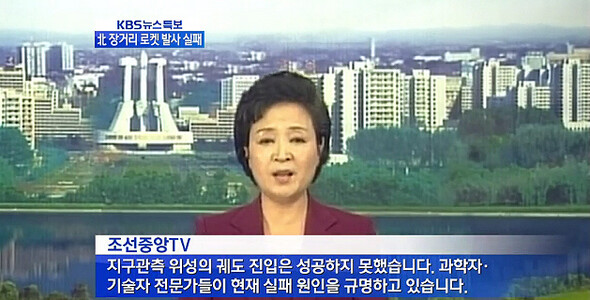hankyoreh
Links to other country sites 다른 나라 사이트 링크
Surprisingly, Pyongyang admits its failure

By Kim Kyu-won, staff writer
North Korea admitted Friday that the Unha-3 rocket failed to enter orbit four hours and 25 minutes after its launch. North Korea had apparently advanced its technology since the failures of the first and second Unha rockets, which North Korea did not acknowledge. But yesterday’s launch also ended in embarrassment.
The Korean Central News Agency reported at 12:03 pm on Friday that “the launch of Kwangmyongsong-3, Choson’s [North Korea’s] first applications satellite, took place at the Yellow Sea satellite launch site in Cholsan County, North Pyongyang, at 7:38:55 am Friday,” but that the Earth observation satellite “did not succeed in entering orbit.”
The agency also reported that scientists, engineers, and experts were looking into the cause of the failure. While short, the report marked the first time North Korea has ever acknowledged the failure of one of its three Unha rocket launches.
The first, launched in 1998, and the second, launched in 2009, are both believed to have failed to enter orbit. The first is believed to have traveled 1,500 km before crashing into the Pacific. The Unha-2 traveled 650 km, dropping its first-stage booster into the East Sea and then traveled 3,800 km with its second-stage booster before it fell into the Pacific.
In terms of firing range, the first was equivalent to a medium-range ballistic missile (MRBM) and the second to an intermediate-range ballistic missile (IRBM).
An intercontinental ballistic missile (ICBM) requires a firing range of over 5,500 km.
But after the Unha-1 launch, North Korea announced that a satellite had been successfully put into orbit with a third-stage booster and was orbiting the Earth sending out songs and signals. After the Unha-2 launch, it announced that it had successfully put an artificial satellite into orbit with the Unha-2 carrier rocket. This time, however, it announced the entry failure roughly four hours later after it happened.
Experts noted that Pyongyang had little room to argue that the launch succeeded in putting a satellite into orbit when the failure was obvious.
“In the past, they had some small basis for claiming success because the first- or second-stage booster separated,” said Inje University professor Kim Yeon-chul. “This time, there was an explosion right after the launch and the rocket fell into the Yellow Sea, so it looks like there wasn‘t any room for making any claims.”
Analysts also said North Korea’s actions were influenced by awareness of forthcoming United Nations Security Council discussions on possible sanctions.
University of North Korea Studies professor Yang Mu-jin said, “They can’t really get out of discussions on UNSC sanctions by claiming it was a satellite, but there may be the aim of minimizing responsibility by playing up the fact that it was a satellite launch.”
Another factor that would have prevented North Korea from making over-the-top claims was the fact that the whole world was watching the launch, with nearly 100 experts and journalists visiting the country.
A government official suggested that North Korea also took into account the greater possibility that South Korea would collect the fragments, which fell into the West Sea.
Please direct questions or comments to [english@hani.co.kr]
Editorial・opinion
![[Column] Park Geun-hye déjà vu in Yoon Suk-yeol [Column] Park Geun-hye déjà vu in Yoon Suk-yeol](https://flexible.img.hani.co.kr/flexible/normal/500/300/imgdb/original/2024/0424/651713945113788.jpg) [Column] Park Geun-hye déjà vu in Yoon Suk-yeol
[Column] Park Geun-hye déjà vu in Yoon Suk-yeol![[Editorial] New weight of N. Korea’s nuclear threats makes dialogue all the more urgent [Editorial] New weight of N. Korea’s nuclear threats makes dialogue all the more urgent](https://flexible.img.hani.co.kr/flexible/normal/500/300/imgdb/original/2024/0424/7317139454662664.jpg) [Editorial] New weight of N. Korea’s nuclear threats makes dialogue all the more urgent
[Editorial] New weight of N. Korea’s nuclear threats makes dialogue all the more urgent- [Guest essay] The real reason Korea’s new right wants to dub Rhee a founding father
- [Column] ‘Choson’: Is it time we start referring to N. Korea in its own terms?
- [Editorial] Japan’s rewriting of history with Korea has gone too far
- [Column] The president’s questionable capacity for dialogue
- [Column] Are chaebol firms just pizza pies for families to divvy up as they please?
- [Column] Has Korea, too, crossed the Rubicon on China?
- [Correspondent’s column] In Japan’s alliance with US, echoes of its past alliances with UK
- [Editorial] Does Yoon think the Korean public is wrong?
Most viewed articles
- 1‘We must say no’: Seoul defense chief on Korean, USFK involvement in hypothetical Taiwan crisis
- 2N. Korean delegation’s trip to Iran shows how Pyongyang is leveraging ties with Moscow
- 3‘Weddingflation’ breaks the bank for Korean couples-to-be
- 4[Column] Park Geun-hye déjà vu in Yoon Suk-yeol
- 5Korea sees more deaths than births for 52nd consecutive month in February
- 6[Guest essay] The real reason Korea’s new right wants to dub Rhee a founding father
- 7[Column] The clock is ticking for Korea’s first lady
- 8[Column] Has Korea, too, crossed the Rubicon on China?
- 9Why Korea shouldn’t welcome Japan’s newly beefed up defense cooperation with US
- 10Will NewJeans end up collateral damage in internal feud at K-pop juggernaut Hybe?